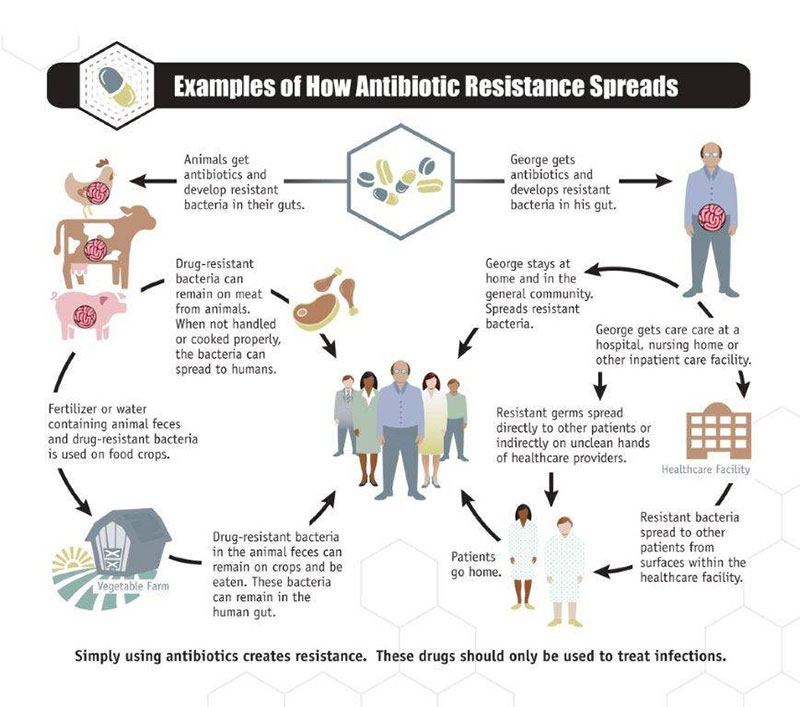The United States faces possible “catastrophic” ramifications with antibiotic-drug-resistant microbes that cause illness, according to an alarming report released by the U.S. Government’s Centers for Disease Control and Prevention (CDC) on September 16, 2013.
The CDC’s 114-page report, Antibiotic Resistance Threats in the United States, 2013 outlines a “first-ever snapshot of the burden and threats posed by the antibiotic-resistant germs having the most impact on human health.”
The U.S. Government agency says two million Americans annually are infected with antibiotic-drug-resistant bacteria, and approximately 23,000 people die every year from these infections.Some die from “other conditions that were complicated by an antibiotic-resistant infection.”
CDC director Dr. Thomas Frieden tells Newsday reporter Delthia Ricks in a September 16, 2013 article exactly what this means to the American public.
“If we’re not careful, the medicine chest will be empty,” Dr. Frieden says in an interview with the Long Island, NY-based newspaper. “Without urgent action now, more patients will be thrust back to a time before we had effective drugs.”
On the CDC website, officials say antibiotic-resistant infections can happen anywhere. Although most data shows such infections happen within the general population, “most deaths related to antibiotic resistance happen in healthcare settings, such as hospitals and nursing homes.”
The CDC defines antibiotic resistance as “the ability of bacteria or other microbes to resist the effects of an antibiotic. Antibiotic resistance occurs when bacteria change in some way that reduces or eliminates the effectiveness of drugs, chemicals, or other agents designed to cure or prevent infections. The bacteria survive and continue to multiply causing more harm.”
The CDC report covers bacteria “causing severe human infections and the antibiotics used to treat those infections.” Candida, a “fungus that commonly causes serious illness, especially among hospital patients,” was included because it has been showing increasing resistance to treatment. Also, infections caused by the bacteria Clostridium difficile (C. difficile) were included.
“Although Clostridium difficile infections are not yet significantly resistant to the drugs used to treat them, most are directly related to antibiotic use and thousands of Americans are affected each year,” the report says.
Clostridium difficile is particularly prevalent in hospitals and responsible for 14,000 of the 23,000 annual deaths of antibiotic-resistant illnesses in the U.S., Dr. Frieden tells Newsday. The newspaper says 16,000 cases are reported in New York State annually.
Three Classes of the Most Dangerous Microbes
The CDC has delineated three classes of especially menacing microorganisms based on levels of threat to the American public.
Urgent Threats
- Clostridium difficile
- Carbapenem-resistant Enterobacteriaceae (CRE)
- Drug-resistant Neisseria gonorrhoeae
Serious Threats
- Multidrug-resistant Acinetobacter
- Drug-resistant Campylobacter
- Fluconazole-resistant Candida (a fungus)
- Extended spectrum beta-lactamase producing Enterobacteriaceae (ESBLs)*
- Vancomycin-resistant Enterococcus (VRE)
- Multidrug-resistant Pseudomonas aeruginosa
- Drug-resistant Non-typhoidal Salmonella
- Drug-resistant Salmonella Typhi
- Drug-resistant Shigella
- Methicillin-resistant Staphylococcus aureus (MRSA)
- Drug-resistant Streptococcus pneumoniae
- Drug-resistant tuberculosis
Concerning Threats
- Vancomycin-resistant Staphylococcus aureus (VRSA)
- Erythromycin-resistant Group A Streptococcus
- Clindamycin-resistant Group B Streptococcus
*Newsday says, regarding ESBLs, “Beta-lactamas is an enzyme, and bacteria that contain it are resistant to a wide variety of penicillins and cephalosporins.”
The CDC has many useful pages on its website to inform consumers about antibiotics. The website page “Get Smart: When Antibiotics Won’t Work for You” discusses prescription antibiotics and their effect on common illnesses such as sinus infection (sinusitis), sore throat, ear infections, common cold and runny nose, and bronchitis (chest cold).
The CDC outlines the following four core actions in Antibiotic Resistance Threats in the United States, 2013 to halt the spread of antibiotic resistance:
- Preventing infections from occurring and preventing resistant bacteria from spreading
- Tracking resistant bacteria
- Improving the use of antibiotics
- The development of new antibiotics and new diagnostic tests for resistant bacteria.
The report also includes information on “what groups such as states, communities, doctors, nurses, patients, and CDC” can do to fight antibiotic resistance.
“Preventing the spread of antibiotic resistance can only be achieved with widespread engagement, especially among leaders in clinical medicine, healthcare leadership, agriculture, and public health,” the CDC’s website says.
 CDC Antibiotic Infographic. Infographic: Courtesy of CDC
CDC Antibiotic Infographic. Infographic: Courtesy of CDC
(Top photo) Antibiotic resistance tests; the bacteria in the culture on the left are sensitive to the antibiotics contained in the white paper discs. The bacteria on the right are resistant to most of the antibiotics. Photo: Dr. Graham Beards at en.Wikipedia/Wikimedia Commons
About UMHS:
Built in the tradition of the best US universities, the University of Medicine and Health Sciences focuses on individual student attention, maintaining small class sizes and recruiting high-quality faculty. We call this unique approach, “personalized medical education,” and it’s what has led to our unprecedented 96% student retention rate, and outstanding residency placements across the US and Canada. UMHS is challenging everything you thought you knew about Caribbean medical schools.

Scott is Director of Digital Content & Alumni Communications Liaison at UMHS and editor of the UMHS Endeavour blog. When he's not writing about UMHS students, faculty, events, public health, alumni and UMHS research, he writes and edits Broadway theater reviews for a website he publishes in New York City, StageZine.com.















